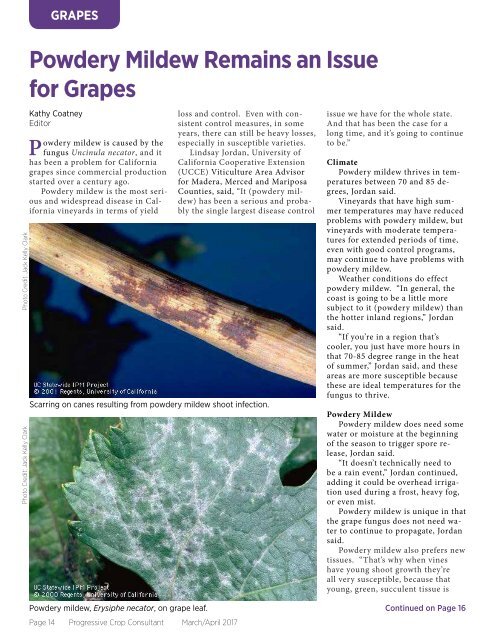Mar_Apr_PCC_2017_Web
Create successful ePaper yourself
Turn your PDF publications into a flip-book with our unique Google optimized e-Paper software.
GRAPES<br />
Photo Credit: Jack Kelly Clark<br />
Photo Credit: Jack Kelly Clark<br />
Powdery Mildew Remains an Issue<br />
for Grapes<br />
Kathy Coatney<br />
Editor<br />
Powdery mildew is caused by the<br />
fungus Uncinula necator, and it<br />
has been a problem for California<br />
grapes since commercial production<br />
started over a century ago.<br />
Powdery mildew is the most serious<br />
and widespread disease in California<br />
vineyards in terms of yield<br />
loss and control. Even with consistent<br />
control measures, in some<br />
years, there can still be heavy losses,<br />
especially in susceptible varieties.<br />
Lindsay Jordan, University of<br />
California Cooperative Extension<br />
(UCCE) Viticulture Area Advisor<br />
for Madera, Merced and <strong>Mar</strong>iposa<br />
Counties, said, “It (powdery mildew)<br />
has been a serious and probably<br />
the single largest disease control<br />
Scarring on canes resulting from powdery mildew shoot infection.<br />
issue we have for the whole state.<br />
And that has been the case for a<br />
long time, and it’s going to continue<br />
to be.”<br />
Climate<br />
Powdery mildew thrives in temperatures<br />
between 70 and 85 degrees,<br />
Jordan said.<br />
Vineyards that have high summer<br />
temperatures may have reduced<br />
problems with powdery mildew, but<br />
vineyards with moderate temperatures<br />
for extended periods of time,<br />
even with good control programs,<br />
may continue to have problems with<br />
powdery mildew.<br />
Weather conditions do effect<br />
powdery mildew. “In general, the<br />
coast is going to be a little more<br />
subject to it (powdery mildew) than<br />
the hotter inland regions,” Jordan<br />
said.<br />
“If you’re in a region that’s<br />
cooler, you just have more hours in<br />
that 70-85 degree range in the heat<br />
of summer,” Jordan said, and these<br />
areas are more susceptible because<br />
these are ideal temperatures for the<br />
fungus to thrive.<br />
Powdery Mildew<br />
Powdery mildew does need some<br />
water or moisture at the beginning<br />
of the season to trigger spore release,<br />
Jordan said.<br />
“It doesn’t technically need to<br />
be a rain event,” Jordan continued,<br />
adding it could be overhead irrigation<br />
used during a frost, heavy fog,<br />
or even mist.<br />
Powdery mildew is unique in that<br />
the grape fungus does not need water<br />
to continue to propagate, Jordan<br />
said.<br />
Powdery mildew also prefers new<br />
tissues. “That’s why when vines<br />
have young shoot growth they’re<br />
all very susceptible, because that<br />
young, green, succulent tissue is<br />
Powdery mildew, Erysiphe necator, on grape leaf.<br />
Page 14 Progressive Crop Consultant <strong>Mar</strong>ch/<strong>Apr</strong>il <strong>2017</strong><br />
Continued on Page 16


















